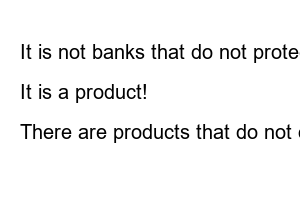예금자 보호법 해당없는 은행Challenge & self study & review
A while ago, I was investigating the difference between the 1st and 2nd financial markets. I also learned a lot about the Deposit Protection Act. I thought the bank was done, but I thought it was only 1 financial sector because of the savings bank crisis. By the way, is Saemaul Geumgo, the second financial sector? So, are you saying that there are some banks that work and some that don’t!?
As many people know, the limit of the Depositor Protection Act is 50 million won. However, the reason I wrote 100 million is that many countries set the depositor protection limit at about 100 million. Even in China. But in Korea, the limit of the depositor protection law is 50 million won!? So recently, there is talk of increasing it to 100 million.
What are the limits of depositor protection laws in other countries?
The average protection limit for countries called the G7 is over 100 million.
France, Italy and the UK are on the same level as Germany.
Of course, Korea’s GDP is still a little short, but the depositor protection limit is still far short of GDP.
First of all, a bank, which is the first financial sector, is a group in which the depositor protection law is observed. Then, will Toss Bank, Kakao Bank, and K Bank be subject to the Depositor Protection Act?
The answer is ‘Yes’.
Internet banks such as Toss, Kakao, and K-bank also need to sign up for depositor insurance as the first financial institution.
Yes!
Looking at the
Citibank and SC First Bank are also eligible.
The majority of banks in the secondary financial sector, including Saemaul Geumgo, have created their own funds to provide depositor protection with a limit of 50 million won per person. Saemaul Geumgo, mutual savings banks, credit unions, fisheries cooperatives, etc. are operating depositor protection systems not with the Depositor Protection Act, but with funds that have emerged by themselves.
In addition, these days, in addition to Saemaul Geumgo and various cooperatives, Welcome Loan or Rush & Cash are also making savings banks and accepting deposits. In the case of Wellcome Loan, Rush & Cash, a wellcome savings bank, OK Savings Bank was created by its parent company, Afro Financial. These various savings banks are also said to be subject to the Depositor Protection Act.
(However, always ask just in case you are covered under the Depositor Protection Act!)
in conclusion..
Almost all financial institutions do.
It could be a stock exchange or an insurance company.
(Insurance companies are actually a bit ambiguous. If the insurance company goes bankrupt, they cancel all insurance on the day of the ruin and give you the amount you paid. For example, I put in 10 million won, but if I cancel today, only 3 million won will be paid. I will receive it. Should I say that this is not possible?)
It is not banks that do not protect depositors.
It is a product!
There are products that do not offer deposit protection. A typical example is a fund. Also, the housing subscription bankbook where you pour money to buy a house is also a product that does not protect depositors. (I think it will give money because it is operated by the state, but it is still a product that is not protected in principle.) So, when signing up for a product at a bank, don’t make it a good opportunity, but be sure to ask if the depositor is protected.

